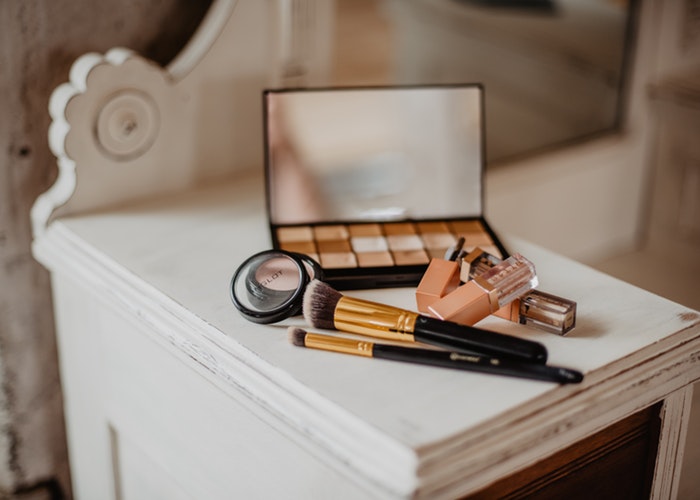Your Makeup Is Grosser Than You Think — Here’s How To Clean It

Makeup is meant to be fun. Whether you’re experimenting with different shades, dressing up for a special occasion, or adding a pop of color to finish off a look, it’s an inherently enjoyable process. But the often tedious process of sanitizing your makeup collection? That’s less fun. It’s something that needs to be done, but we all have a tendency to forget about it.
There are a number of consequences to using expired or dirty makeup, though. You could suffer breakouts, skin irritation, or even infections. Liquid eye products like mascara or liquid liners are particularly sensitive to contamination and could result in styes or pink eye. Of course, getting an infection is a worst-case scenario, but it’s not worth the risk, and aside from health concerns, your products will often become less effective over time. And who wants to use chalky eyeshadow or dry liquid liner?
As someone who worked in cosmetics for many years, I’ve picked up some tips and tricks that I still use to this day. I have a makeup cleaning routine I go through every three to six months, and here are some basics to consider when implementing your own process.
Look for expiration dates and guidelines.
Perhaps the most important part of keeping your makeup collection clean and tidy is understanding expiration dates and guidelines. For the most accurate expiration information, look no further than your makeup packaging. Each product should have an indication of how many months it will last after opening.
You’ll usually find this information on the product packaging, or on the lid of the product. You’ll find a number or some text that might read “period after opening.” For example, if the icon reads 6M, it means that you can safely use the product for six months after you’ve opened it.
The product’s own label will take everything into account, from its ingredients to its packaging, and give you the best idea of how long it will last. If, however, you don’t have access to that indication — let’s say you threw out the box it came with and there isn’t an icon on the product itself — there are general guidelines you can consult. Home Storage Solutions has a nice cheat sheet here, which is what I use.
Again, liquid eye products are the riskiest in terms of contamination, and liquid foundations and similar products are a close second, so be sure to toss them as soon as they’re expired. Additionally, if a liquid product contains SPF, it should actually have a set “best before” date written somewhere on it, so be sure to toss it if you pass that date.
Label each new product you open.
This might seem time-consuming and rather annoying, but the most effective way to keep track of expiration dates is to use labels. Every time you open a new piece of makeup, take a small label or Post-it note and write down the date you’ve opened it, then stick it to your makeup. Bonus points if you consult the packaging and include the exact date it will expire.
So if you open a new mascara in March 2020 and the packaging indicates that it will last 3 months after opening, you’d write: OPENED MARCH 2020. EXPIRES JUNE 2020. You can even put a strip of clear tape on top of the label to make sure it doesn’t rub off.
If you get into this habit, it will save you so much time down the road. All you’ll have to do is look at your handwritten label, see if the product is past its expiration date, and keep or toss it accordingly.
Sanitize powders and lipstick with rubbing alcohol.
The easiest way to disinfect makeup products is with rubbing alcohol. 70% concentration or more is ideal. You can typically find a bottle at your local dollar store or drugstore for just a few dollars. Keep it beside a container of cotton pads, and you’re good to go.
Powder products typically have the most longevity out of all your makeup products; they can last up to two years. So if you want to keep your eyeshadows and face powders sanitary, you can spray a small amount of rubbing alcohol onto them and wipe them off with a cotton pad or tissue.
To sanitize lipsticks, spray some rubbing alcohol onto a cotton pad and give them a swipe. Keep in mind, this applies to lipsticks that come in standard tubes — not liquid lipsticks.
Regularly sharpen your lip and eye pencils.
Like powders, makeup pencils also have a long shelf life. At least, this is true for lip and eye pencils that you can sharpen. The best way to keep those types of products sanitary is to sharpen them regularly to keep them fresh.
If you haven’t used one of your pencils in a while, next time you pick it up, make sure to give it a quick sharpen.
Disinfect makeup containers and surfaces.
Another important step in keeping your makeup collection clean is to disinfect the containers you keep them in. If you use a makeup organizer, clean it with disinfectant wipes or rubbing alcohol at least once every few months.
And if you have a dedicated makeup desk or space, be sure to wipe it down often, too, as part of your usual, weekly household cleaning.
Always wash your tools.
Cleaning your makeup brushes could be an article all on its own, but as a basic rule, you should wash them every single week.
If you use dirty brushes on your freshly cleaned makeup products, you will just undo all of your hard work. Think of your makeup brushes like dishes that you use to eat on. You wouldn’t use a dirty kitchen knife to slice fresh produce, so why take the risk with your makeup products?
Skip the makeup when sick.
Another good rule of thumb: Avoid using makeup products when you’re sick. If you use them while battling an infection or cold, you risk transferring germs and bacteria to the products. Then, when you’re feeling better and you reuse those products, you’re at risk of contracting the same illness again.
If you have any makeup products nearing their expiration, you could potentially use those while you’re sick, and then just toss them once you’re feeling better. That way, at least you’re not wasting new makeup. And if you’re trying to cut down on makeup costs while still tossing products on a timely basis, try reading a past article for TFD I wrote about streamlining your collection.
*****
Having a cleaning routine in place for your makeup can help you avoid skin issues down the road. Here’s how you can use this information in practice:
- Always label newly opened makeup products.
- Take basic precautions such as washing your makeup tools, cleaning surfaces on which you do your makeup, and avoiding application while sick.
- Every few months, sit down for about half an hour to sort through your entire collection. Toss expired products, sanitize your containers, try using rubbing alcohol to keep existing products clean and sharpen all pencils.
If you keep up with these practices, you’ll have a collection that’s organized and clean. While it can seem painful to toss expired makeup products, especially when you’re on a budget, it will save you the hassle of dealing with skin issues or even illness down the road.
Mercedes Killeen is a Toronto-based freelance writer and editor. You can learn more about her work, and order her freelance services, at mercedeskilleen.com.
Image via Pexels
Like this story? Follow The Financial Diet on Facebook, Instagram, and Twitter for daily tips and inspiration, and sign up for our email newsletter here.




